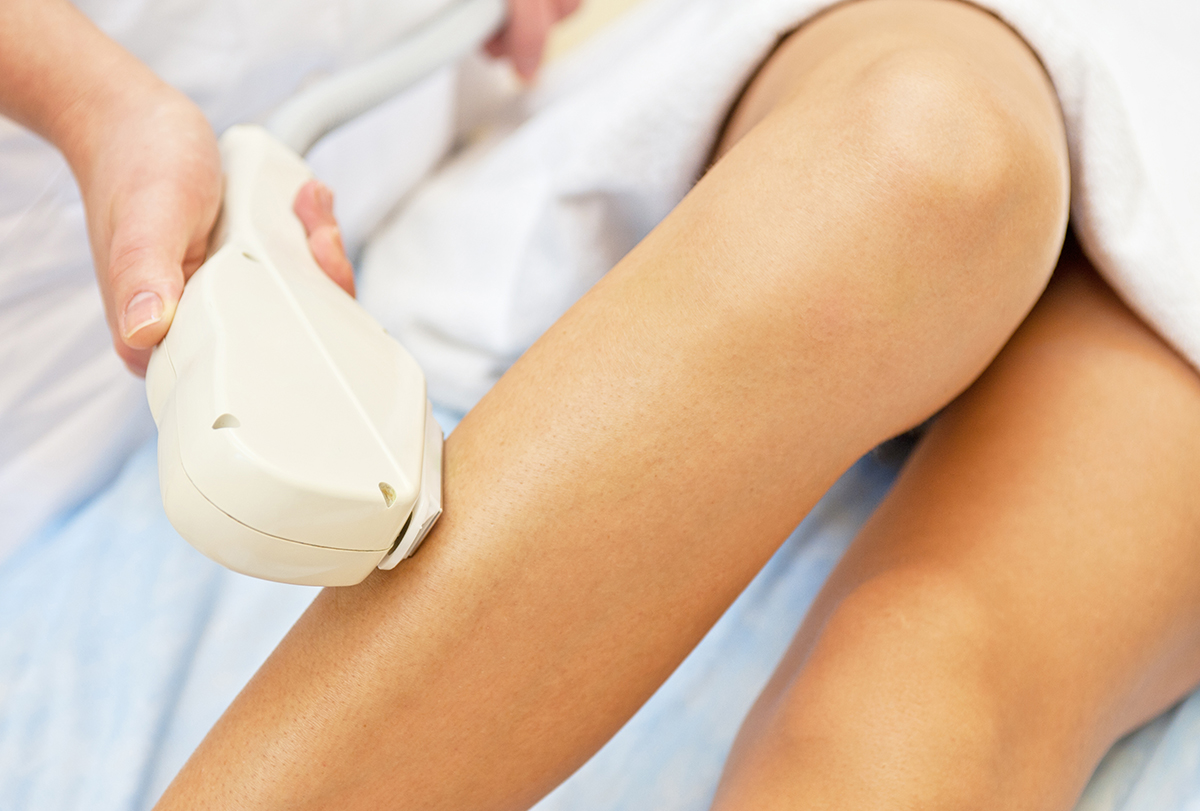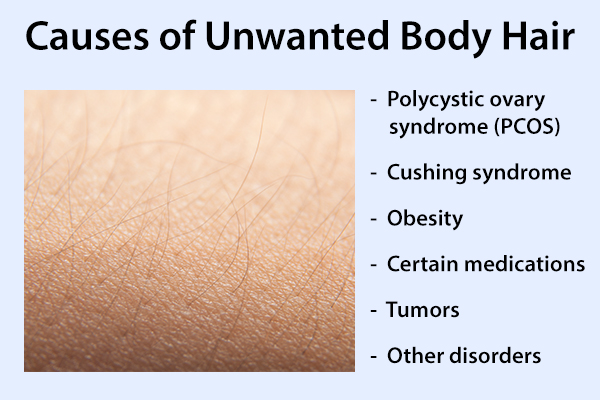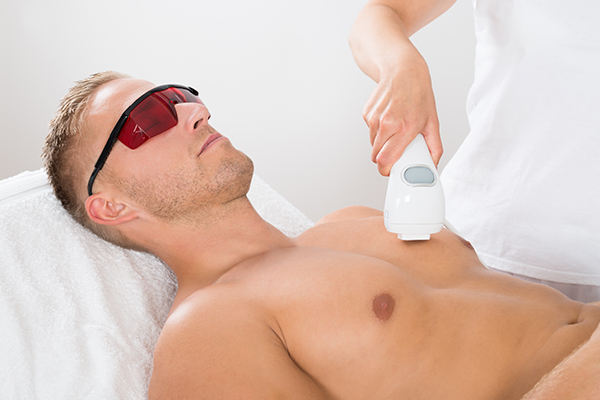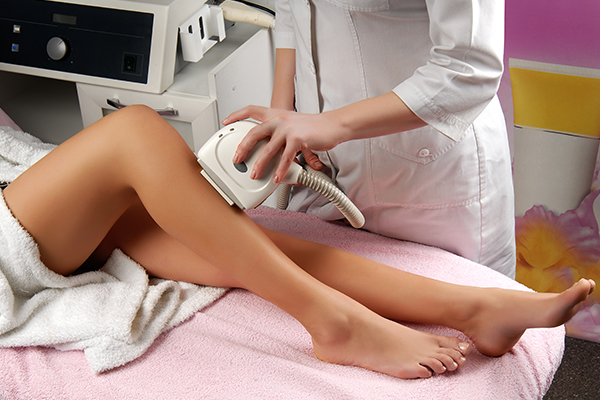In this article:
Body hair on women or excessive growth of hair on body parts such as the face is medically known as hirsutism. Hirsutism is not so much a medical condition but a symptom of different underlying conditions, most of which affect the balance of hormones, especially androgens.

The most common cause of hirsutism is polycystic ovary syndrome (PCOS), wherein the androgen production in women is increased. This condition is quite common, affecting up to 10% of women. (1)(2)
Hirsutism may also develop due to hereditary factors and is called familial hirsutism.
Factors Responsible for Unwanted Body Hair

In many cases, the cause of hirsutism cannot be pinpointed, but various underlying medical conditions can cause excessive unwanted body hair, including the following:
- Polycystic ovary syndrome (PCOS). PCOS is characterized by a hormonal imbalance in the body that can lead to irregular periods, infertility, obesity, cysts on the ovaries, and unwanted hair growth. This condition often begins in puberty. (1)(3)
- Cushing syndrome. This condition is caused by an increased cortisol level in the body due to the overworking of the adrenal glands or prolonged use of medications such as prednisone. (3)
- Obesity. Excess body weight can increase the production of male hormones in the body, causing the growth of body hair in women. (4)
- Certain medications. Medications such as minoxidil, danazol, and phenytoin can cause unwanted hair growth. (3)
- Tumors. Ovarian tumors can cause an increase in androgen production, therefore causing hirsutism. (5)
- Other disorders. Problems in the thyroid gland, adrenal gland, pituitary gland, or ovaries can cause a sudden development of male characteristics such as a deep voice, acne, and hirsutism.
Symptoms of Hirsutism (Unwanted Body Hair)
Hirsutism is characterized by the development of coarse, thick, dark hair on the body in place of normally thin, fine hair. (2) These body parts include the upper arms, chest, back, face, lower abdomen, and upper legs.
Hirsutism may be accompanied by the following symptoms as well:
- Weight gain
- Hyperpigmentation
- High prolactin level
- Hair loss or androgenetic alopecia
- Acne
- Irregular menstrual periods
- Deep voice
- Acanthosis nigricans or the formation of warts in skin folds
- Infertility
- High insulin levels
Treatment for Unwanted Body Hair

Hirsutism can be effectively managed with oral and topical medications and in-office treatments. Multiple sessions may be needed as the condition cannot be completely cured.
Oral and topical medications
Oral and topical medications help control the hair growth. However, you may only see results after up to 6 months of the treatment, until the hair follicle life cycle is complete.
The different treatment options include:
- Oral contraceptives. These are the most common form of treatment for hirsutism. Oral hormonal contraceptives or birth control pills contain progestin and estrogen that limit androgen production, therefore helping manage hirsutism. (1)
- Anti-androgens. Anti-androgens block the action of androgens by attaching themselves to androgen receptors in the body. These medications are generally used if oral contraceptives fail even after 6 months of treatment. Common anti-androgen drugs used in the treatment of hirsutism include spironolactone (Aldactone, CaroSpir) and finasteride. (1)(6)
- Inositol. Myo-inositol and D-chiro-inositol can also help in the treatment of hirsutism. It is suggested to take the medication half hour before meals and refrain from consuming caffeine for up to 2 hours before taking the medication. (7)
- Topical creams. Eflornithine hydrochloride (Vaniqa®) cream is a topical medication that helps control hair growth. The treatment may take up to 8 weeks to show results and needs to be continued for some time. This cream is often used as an adjunct to other treatments. (1)(2)
In-Office treatments

In addition to medications, in-office treatments may be recommended by your doctor. These treatments remove the hair quickly, after which you can manage the hair growth with oral and topical medications.
Common in-office treatments include:
a. Electrolysis
Hair is removed from the root using a mild electric current. Repetitive treatment with electrolysis eventually limits and even stops hair growth in the treated area.
b. Intense pulsed light (IPL)
Broad-spectrum light is employed to remove unwanted hair. This treatment is mostly used if the skin color and hair color are vastly different, such as light skin and dark, black hair.
c. Photo epilation (laser) treatments
A concentrated beam of light removes hair by destroying the hair follicles. Also known as photo-epilation, laser treatments have a long-lasting effect after a few sessions. However, the treatment may be painful and expensive. (1)
Laser hair removal can be of different types depending on the laser used:
- Alexandrite laser hair removal: Generally suggested for people with light skin tones, alexandrite hair removal uses short wavelengths to remove hair. It is less painful than other treatments but may require more sessions in comparison to other laser treatments for permanent hair removal. Regardless, the effect of a single session of laser hair removal lasts longer than other methods such as shaving, waxing, and threading.
- Diode laser hair removal: Diode lasers use a longer wavelength of light that can travel deeper into the skin. These lasers are generally recommended for people with coarse hair and medium-dark skin.
- Nd:YAG laser: Useful in the treatment of ingrown hair, Nd:YAG laser is a highly effective hair removal treatment as it destroys the hair follicles by blocking blood supply, therefore preventing further hair growth.
Diagnosing Hirsutism

Making a diagnosis of hirsutism and identifying its underlying cause primarily involve a medical history, physical exam, and analysis of symptoms. The healthcare provider will look at your hair growth and will check for associated symptoms such as acne.
In addition, the doctor may order the following tests to help detect the underlying cause:
- Blood tests for hormone levels
- Ultrasound to check the uterus and ovaries
- X-ray of the adrenal glands
When to See a Doctor
It is best to consult a doctor as soon as you suspect hirsutism as delaying treatment may make it difficult to control the hair growth. Also, get yourself checked by a healthcare provider if you notice body hair along with irregular periods, deep voice, or other masculine characteristics.
However, if you have always had excess body hair, have other family members with excessive hair growth, and do not have any of the other above-mentioned problems, you may not need to consult your doctor.
Final Word
Hirsutism is a common condition among women, which can have different underlying conditions but can often be managed with medical treatment. It is best to seek timely treatment as the underlying condition may worsen with time.
The treatment for hirsutism is generally ongoing, as it is difficult to remove the hair completely. Proper treatment and care can however control the growth of hair and decrease its density.

- Was this article helpful?
- YES, THANKS!NOT REALLY


